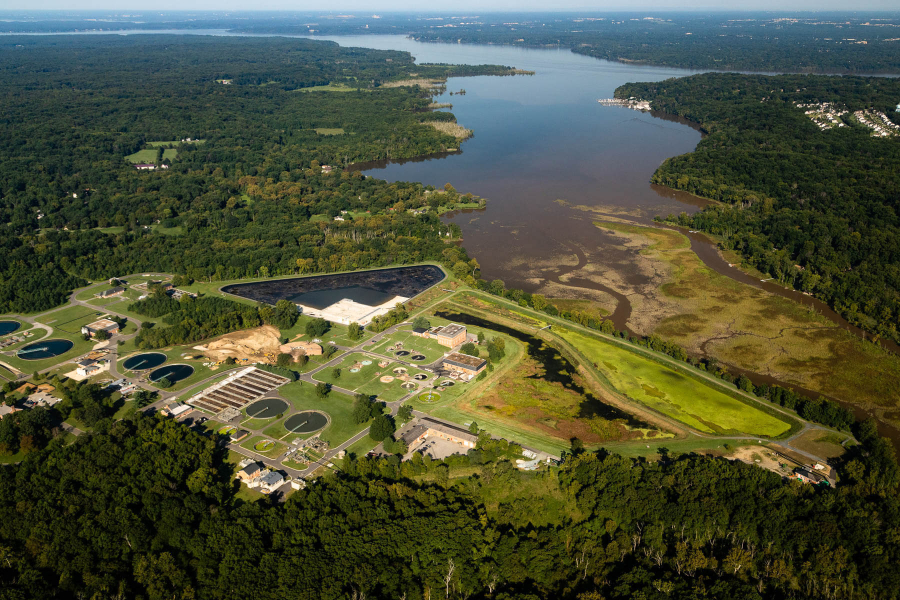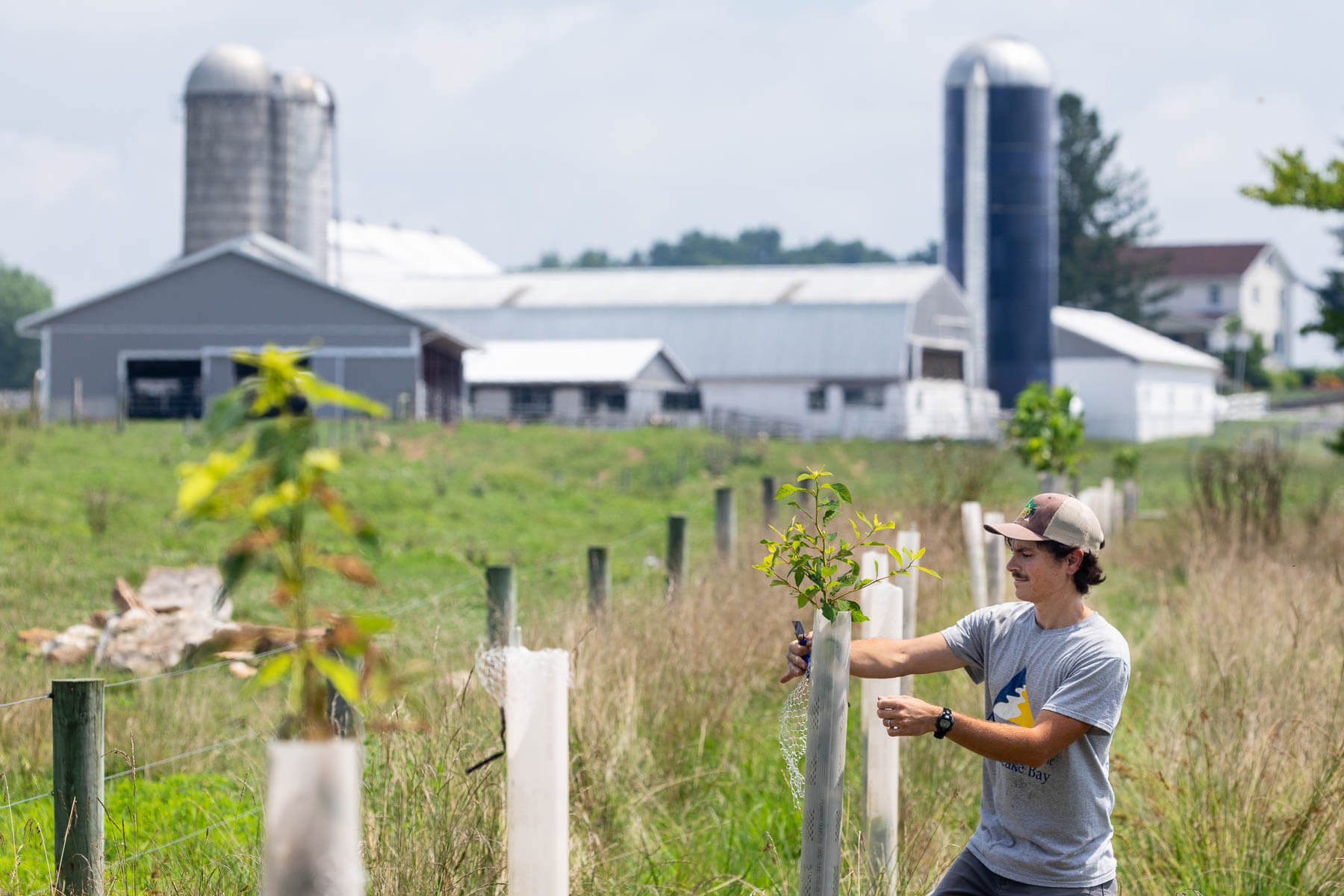Wastewater treatment plant upgrades help reduce nitrogen pollution entering the Bay
Sediment pollution also declines, thanks in part to the efforts of our farmers

Every year, the seven watershed jurisdictions—Delaware, the District of Columbia, Maryland, New York, Pennsylvania, Virginia and West Virginia—submit data about the pollution reducing practices that they have put into place to the Chesapeake Bay Program. Experts take that information and run it through a sophisticated suite of modeling tools to estimate the amount of nitrogen, phosphorus and sediment pollution that is entering the Chesapeake Bay.
Through the Chesapeake Bay Watershed Agreement, the Chesapeake Bay Program commits to having 100% of the practices in place by 2025 that would achieve all of the nitrogen, phosphorus and sediment reductions necessary to meet the goals outlined in the Chesapeake Bay Total Maximum Daily Load (Bay TMDL). The Environmental Protection Agency also uses this information to evaluate each jurisdiction’s two-year milestones, which are reports that track their individual progress toward meeting these goals.
The most recent data available from the Chesapeake Bay Watershed Model indicate that pollution controls put into place between 2009 and 2019 are estimated to have lowered overall nitrogen pollution by 11%, from 297.9 million pounds in 2009 to 265.3 million pounds in 2019, meeting 39% of the goal to reduce nitrogen by 2025. Phosphorus saw a slight increase from the previous assessment period, but overall levels have declined 10% since 2009 when 17.1 million pounds entered the Bay. In 2019, that figure was 15.3 million pounds, which meets 49% of the goal to reduce phosphorus by 2025.
Excess amounts of nitrogen and phosphorus are among the leading causes of the Bay’s poor health. They can fuel the growth of algae blooms that lead to low-oxygen “dead zones” that suffocate marine life. All across the watershed, jurisdictions are taking the necessary steps to upgrade their wastewater treatment facilities. Excess nitrogen and phosphorus, bacteria, virus, diseases, metal and other substances are found in our wastewater. The implementation of advanced technologies to treat wastewater continues to help reduce the levels of nitrogen and phosphorus that reach the Bay.

Overall sediment decreased 4% from 18.9 billion pounds in 2009 to 18.1 billion pounds in 2019, meeting 100% of the goal to reduce sediment by 2025. Sediment can block sunlight from reaching aquatic grasses in the Bay, as well as suffocate and bury shellfish. Practices to reduce pollution, called best management practices (BMPs) help stem the amount of pollution that enters the Chesapeake Bay. Farmers within the watershed are one group that has helped to reduce the amount of sediment that is flowing into the Bay through BMP implementation. While there is often a lag in measuring the impact that these actions have on the health of the Bay, research shows that implementing BMPs on the land play a significant role in water quality.
"Farmers throughout the Chesapeake Bay watershed have made tremendous strides in the implementation of agricultural best management practices”, said Kate Fritz, executive director of the Alliance for the Chesapeake Bay. “The Alliance continues to be inspired by the creativity and energy that supports the agricultural industry and the leadership that has arisen from the private sector in the past three years. We remain optimistic that partnerships between the private, public and non-profit sectors will activate even greater action to catapult us toward meeting our Bay TMDL goals."
The Watershed Model estimates the following reductions for each jurisdiction between 2009-2019:
- In Delaware, pollution controls have lowered nitrogen loads 11%, phosphorus loads 19% and sediment loads 42%. The state fell short of its 2019 pollution reducing target for nitrogen but met its targets for phosphorus and sediment.
- In the District of Columbia, pollution controls have lowered nitrogen loads 26%, phosphorus loads 11% and sediment loads 19%. The District has met each of its 2019 pollution reducing targets.
- In Maryland, pollution controls have lowered nitrogen loads 12%, phosphorus loads 2% and sediment loads 0%. The state fell short of its 2019 pollution reducing targets for nitrogen and phosphorus but met its target for sediment.
- In New York, pollution controls have lowered nitrogen loads 6%, phosphorus loads 15% and sediment loads 7%. The state fell short of its 2019 pollution reducing targets for nitrogen and sediment but met its target for phosphorus.
- In Pennsylvania, pollution controls have lowered nitrogen loads 4%, phosphorus loads 15% and sediment loads 14%. The Commonwealth has fallen short of each of its 2019 pollution reducing targets.
- In Virginia, pollution controls have lowered nitrogen loads 14% percent, phosphorus loads 10% and sediment loads 2%. The Commonwealth fell short of its 2019 pollution reducing targets for nitrogen and phosphorus but met its target for sediment.
- In West Virginia, pollution controls have lowered nitrogen loads 4%, phosphorus loads 31% and sediment loads 8%. The state has met each of its 2019 pollution reducing targets.
"For many years, jurisdictions in the Bay watershed have and continue to undertake substantial efforts to control and mitigate pollution in the Chesapeake Bay”, said Ed Dunne, chair of the Chesapeake Bay Program’s Water Quality Goal Implementation Team. “These efforts include plans and on-the-ground practices to reduce pollution to meet water quality goals by 2025. Bringing the best available science to the table, in addition to learning from each jurisdiction’s experiences is critical to achieving pollutant reduction targets and collectively attaining our water quality goals."
To learn more about our progress toward having practices and controls in place to achieve a healthy Bay by 2025, visit ChesapeakeProgress.

Comments
There are no comments.
Thank you!
Your comment has been received. Before it can be published, the comment will be reviewed by our team to ensure it adheres with our rules of engagement.
Back to recent stories